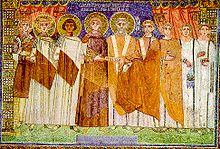Constantine IV
| Constantine IV Κωνσταντῖνος Δ' |
|||||
|---|---|---|---|---|---|

Constantine IV and his retinue, mosaic in basilica of Sant'Apollinare in Classe (Ravenna)
|
|||||
| Emperor of the Byzantine Empire | |||||
| Reign | 15 September 668 – 14 September 685 | ||||
| Predecessor |
Mezezius Constans II |
||||
| Successor | Justinian II | ||||
| Born | 652 Constantinople |
||||
| Died | 14 September 685 (aged 33) Constantinople |
||||
| Spouse | Anastasia | ||||
| Issue |
Justinian II Heraclius |
||||
|
|||||
| Dynasty | Heraclian Dynasty | ||||
| Father | Constans II | ||||
| Mother | Fausta | ||||
| Full name | |
|---|---|
| Flavius Constantinus |
| Heraclian dynasty | |||
| Chronology | |||
| Heraclius | 610–641 | ||
| with Constantine III as co-emperor, 613–641 | |||
| Constantine III | 641 | ||
| with Heraklonas as co-emperor | |||
| Heraklonas | 641 | ||
| Constans II | 641–668 | ||
| with Constantine IV (654–668), Heraclius and Tiberius (659–668) as co-emperors | |||
| Constantine IV | 668–685 | ||
| with Heraclius and Tiberius (668–681), and Justinian II (681–685) as co-emperors | |||
| Justinian II | 685–695, 705–711 | ||
| with Tiberius as co-emperor, 706–711 | |||
| Succession | |||
|
Preceded by Justinian dynasty and Phocas |
Followed by Twenty Years' Anarchy |
||
Constantine IV (Greek: Κωνσταντῖνος Δ', Kōnstantinos IV, Latin: Flavius Constantinus Augustus) (c. 652 – 14 September 685), sometimes incorrectly called Pogonatos, "the Bearded", out of confusion with his father, was Byzantine Emperor from 668 to 685. His reign saw the first serious check to nearly 50 years of uninterrupted Islamic expansion, while his calling of the Sixth Ecumenical Council saw the end of the monothelitism controversy in the Byzantine Empire.
The eldest son of Constans II, Constantine IV had been named a co-emperor with his father in 654. He had been given the responsibility of managing the affairs at Constantinople during his father’s extended absence in Italy and became senior Emperor when Constans was assassinated in 668. His mother was Fausta, daughter of patrician Valentinus.
The first task before the new Emperor was the suppression of the military revolt in Sicily under Mezezius which had led to his father's death. Within seven months of his accession, Constantine IV had dealt with the insurgency with the support of Pope Vitalian. But this success was overshadowed by troubles in the east.
As early as 668 the Caliph Muawiyah I received an invitation from Saborios, the commander of the troops in Armenia, to help overthrow the Emperor at Constantinople. He sent an army under his son Yazid against the Eastern Roman Empire. Yazid reached Chalcedon and took the important Byzantine center Amorion. While the city was quickly recovered, the Arabs next attacked Carthage and Sicily in 669. In 670 the Arabs captured Cyzicus and set up a base from which to launch further attacks into the heart of the Empire. Their fleet captured Smyrna and other coastal cities in 672. Finally, in 672, the Arabs sent a large fleet to attack Constantinople by sea. While Constantine was distracted by this, the Slavs unsuccessfully attacked Thessalonika.
...
Wikipedia
